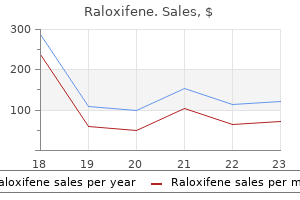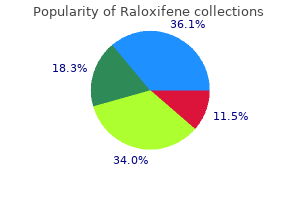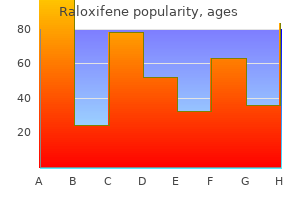

Raloxifene dosages: 60 mg
Raloxifene packs: 30 pills, 60 pills, 90 pills, 120 pills, 180 pills, 270 pills, 360 pills

The molecular genetic testing performed should be guided by the clinical phenotype and also the relative prevalence of mutations within that population pregnancy 50 effaced 60 mg raloxifene cheap overnight delivery. As many of these conditions are familial, the characteristics of other family members should also be considered. For similar reasons the results of molecular testing should be interpreted in the context of the clinical findings. Where a family member has a confirmed genetic diagnosis, phenotypically unaffected relatives should be tested to assess whether they will be at risk of developing diabetes in the future. Where the main mutation phenotype is diabetes, regular urine or blood testing may be preferable as there is little clear extra benefit from prospective testing. Where families do request predictive testing, they should receive full counseling on the potential benefits and disadvantages and be allowed to make their own decisions on this. Conclusions Monogenic diabetes results from single gene changes that affect -cell function or insulin sensitivity. Correct diagnosis can help define prognosis and the best treatment and allow screening of family members. Pregnancy outcome in patients with raised blood glucose due to a heterozygous glucokinase gene mutation. Counterregulatory responses to hypoglycemia in patients with glucokinase gene mutations. Overexpression of dominant-negative mutant hepatocyte nuclear factor-1 alpha in pancreatic beta-cells causes abnormal islet architecture with decreased expression of E-cadherin, reduced beta-cell proliferation, and diabetes. Beta-cell genes and diabetes: molecular and clinical characterization of mutations in transcription factors. Beta-cell dysfunction, insulin sensitivity, and glycosuria precede diabetes in hepatocyte nuclear factor-1alpha mutation carriers. Best practice guidelines for the molecular genetic diagnosis of maturity-onset diabetes of the young. Successful prospective prediction of type 1 diabetes in schoolchildren through multiple defined autoantibodies: an 8-year followup of the Washington State Diabetes Prediction Study. Sensitivity to sulphonylureas in patients with hepatocyte nuclear factor-1alpha gene mutations: evidence for pharmacogenetics in diabetes.
In its mildest form there are no radiographic changes aside from the tumor women's health center wyckoff purchase raloxifene 60 mg free shipping, but the patient becomes mentally dull, slightly disinhibited, and often sleepy for large parts of the day. Panhypopituitarism is another complication of whole-brain radiotherapy, particularly in children, who may also suffer growth retardation. In the production of radiation necrosis, the total and fractional doses of radiation and the time over which treatment is administered are obviously important factors, but the exact amounts that produce such damage cannot be stated. Other factors, still undefined, must play a part, since similar courses of radiation treatment may damage one patient and leave another unaffected. The severe necrotizing encephalopathy that has followed the combined use of methotrexate (intrathecally but also intravenously) was discussed earlier, under "Involvement of the Nervous System in Leukemia," the condition in which it was first described and formerly was most prevalent. Treatment has consisted of corticosteroids, which may cause regression of symptoms and of edema surrounding the lesion. Very high doses may be necessary, 40 mg or more of dexamethasone (or its equivalent). It is also known that tumors, usually sarcomas, can be induced by radiation, as mentioned earlier (Cavin et al). While well documented, this occurs rarely and only after an interval of many years. We have also seen two cases of fibrosacroma of the brachial plexus region in the radiation field for breast tumors (Gorson et al). These lesions appeared more than 10 years after the initial treatment, and many cases of even longer latency are on record. The various neurologic effects of chemotherapy for systemic tumors, especially polyneuropathy, are discussed in Chaps. A number of other infectious diseases of the nervous system are more appropriately discussed elsewhere in this book. Diseases due to bacterial exotoxins- diphtheria, tetanus, botulism- are considered with other toxins that affect the nervous system (Chap. Leprosy, which is essentially a disease of the peripheral nerves, is described in Chap. Viral infections of the nervous system, because of their frequency and importance, are allotted a chapter of their own (Chap. In a number of cases, infection is iatrogenic, being introduced in the course of cerebral or spinal surgery, the placement of a ventriculoperitoneal shunt, or rarely by a lumbar puncture needle.

There is a hyalinization of the sarcoplasm of many degenerating and nondegenerating fibers menopause treatment options order raloxifene 60 mg visa. In longitudinal sections, these are seen as "contraction bands," expressive of the irritability of dystrophic muscle. This phenomenon may be present before there is any significant degree of degeneration and is more extensive in Duchenne than in any of the other dystrophies. Eventually there are histologic changes that are common to all types of advanced muscular dystrophies: loss of muscle fibers, residual fibers of larger and smaller size than normal- all in haphazard arrangement, and the secondary reaction of an increase in lipocytes and fibrosis. Hypertrophy of muscle is believed to be a result of workinduced enlargement of the remaining sound fibers in the face of adjacent fiber injury. But examples of true hypertrophy of entire muscles prior to the first sign of weakness may also occur and are difficult to explain. In these cases, large fibers may be present when at most there are only a few degenerating fibers. Pseudohypertrophy is due to lipocytic replacement of degenerated muscle fibers, but in its earlier stages the presence of many enlarged fibers contributes importantly to the enlargement of muscle, all secondary changes. Smallness of residual fibers (possibly atrophy) is a prominent histologic feature. It is uncertain if this represents a gradual failure of cell metabolism and reduction in volume of all sarcoplasmic constituents or a stage in the regeneration of the damaged muscle fiber. The fibers do eventually degenerate and disappear, owing presumably to an exhaustion of regenerative capacity after repeated injuries or more and more extensive necrosis. In the late stage of the dystrophic process, only a few scattered muscle fibers remain, almost lost in a sea of fat cells. It is notable that the late or burned-out stage of chronic polymyositis resembles muscular dystrophy in that the fiber population is depleted, the residual fibers are of variable size, and fat cells and endomysial fibrous tissue are increased; lacking only are the hypertrophied fibers of dystrophy. This resemblance confirms that many of the typical changes of muscular dystrophy are nonspecific, reflecting only the chronicity of the myopathic process.

Gross examination of the brain discloses a marked reduction in the cerebral white matter women's health center bakersfield buy 60 mg raloxifene, which feels firm and rubbery. Microscopically, there is widespread myelin degeneration, absence of oligodendrocytes, and astrocytic gliosis in the cerebrum, brainstem, spinal cord, and nerves. The characteristic globoid cells are large histiocytes containing the accumulated metabolite. Visual failure with optic atrophy and a normal electroretinogram is an early finding. Later there is ataxia as well as spastic weakness of the legs, mental regression, and finally decerebration. Adams, a progressive quadriparesis with mild pseudobulbar signs, slowly progressive impairment of memory and other mental functions, dystonic posturing of the arms, and preserved sphincteric control constituted the clinical picture. We have observed another rare variant, beginning in adult years, with spastic quadriparesis (asymmetrical) and optic atrophy. The nerve conduction velocities in the late-onset form may be either normal or abnormal. Kolodny and colleagues have reported 15 cases of even later onset (ages 4 to 73 years); pes cavus, optic pallor, progressive spastic quadriparesis, a demyelinating sensorimotor neuropathy, and symmetrical parieto-occipital white matter changes (on imaging studies) were the main features. Galactocerebrosidase levels were not as much reduced as in the infantile form; possibly these late-onset variants represent a structural mutation of the enzyme (see Farrell and Swedberg). In this disease, as well as others described in this chapter, it has become clear that different mutations involving the same enzyme or metabolic pathway can produce strikingly different phenotypes and that there is a wide range in the age of onset in what had been considered, until relatively recently, a disease confined to infancy and early childhood. The onset is in the first weeks of life, with a hoarse cry due to fixation of laryngeal cartilage, respiratory distress, and sensitivity of the joints, followed by characteristic periarticular and subcutaneous swellings and progressive arthropathy, leading finally to ankylosis. Usually there is severe psychomotor retardation, but a few patients have appeared neurologically normal. The diagnostic abnormality is a deficiency of ceramidase, leading to accumulation of ceramide. Seitelberger has obtained pathologic verification of this lesion in cases beginning as late as adult years. This disease and Cockayne syndrome are the only leukodystrophies in which nystagmus has been an invariable finding.

The characteristic change of segmental demyelination is the disappearance of the sheath over segments of variable length women's health center presbyterian hospital best 60 mg raloxifene, bounded on each end by a preserved segment of myelin. Myelin may also degenerate secondary to axonal disease in a general process that may occur either proximal or distal to the site of axonal interruption. Common to many lesions of the peripheral nerve is the type of reaction of both the axon and myelin distal to axonal disruption called wallerian degeneration. Wallerian degeneration might be described as "dying forward," a process in which the nerve degenerates from the point of axonal damage outward. In contrast, when the axon degenerates as part of a "dyingback" phenomenon in a more generalized metabolically determined polyneuropathy, it is termed axonal degeneration. Here, the axon is affected from the distal-most site to the proximal, with dissolution of myelin that occurs in parallel with the axonal change. One possible explanation for this process is that the primary damage is to the neuronal perikaryon, which fails in its function of synthesizing proteins and delivering them to the distal parts of the axon. There is also the possibility that certain toxic and metabolic processes affect axons uniformly along their length or impair anterograde axonal transport to the periphery; the functional impairment would then be proportional to the size and length of the blocked axons. Destruction of an anterior horn cell or proximal motor root results in a gradual dissolution of the distal motor nerve and its myelin sheath (a form of wallerian degeneration). Similar destruction of the dorsal root produces a secondary wallerian degeneration of the posterior columns of the spinal cord, but not of the peripheral sensory nerve since the dorsal root ganglion cells maintain the integrity of the distal axon. In other words, destruction of axons results within several days in a wallerian degeneration of all the myelin distal to the point of injury. The myelin breaks down into blocks or ovoids in which lie fragments of axons (digestion chambers of Cajal). The myelin fragments are then converted, through the action of macrophages, into neutral fats and cholesterol esters and carried by these cells to the bloodstream. Certain diseases affect the neuron primarily rather than the axon and cause either a motor or sensory neuronopathy.

Torn, 34 years: The increased lipolysis results in increased fatty acid release from fat cells with increase in fatty acid transport to the liver. The mode of inheritance is thought to be autosomal dominant with incomplete penetrance. Tight control of blood pressure delays the progression of retinopathy and nephropathy, while elevated blood pressure accelerates the onset of nephropathy and its progression [172�174]. Further, they were unable to deal with an array of sensory experiences like normal children.
Ernesto, 28 years: The first of these peptides to be isolated from a mollusk had only four amino acids. Similarly, the lipolytic effect of catecholamines is blunted by hyperinsulinemia and accentuated by hypoinsulinemia [93]. Injuries to the hip and knee cause rapid disuse atrophy of the quadriceps muscles. In the experience of Henson and Urich, about half of all patients with nonfamilial, late-onset cerebellar degeneration proved sooner or later to be harboring a neoplasm.
Akrabor, 33 years: Louis reported that 21 percent made a good recovery- mostly those who were alert on admission. Denervation from spinal motor neuron or nerve disease at every age has roughly the same effect- namely, atrophy of muscle fibers (first in random distribution, then in groups) and later, degeneration. Grossly, those in the fourth ventricle are grayish pink, firm, cauliflower-like growths; those in the cerebrum, arising from the wall of the lateral ventricle, may be large (several centimeters in diameter), reddish gray, and softer and more clearly demarcated from adjacent tissue than astrocytomas, but they are not encapsulated. They showed also that in the United States, African Americans are at lower risk than whites at all latitudes, but both races show the same south-to-north gradient in risk, probably indicating the importance of an environmental factor regardless of race.
Grok, 31 years: Quick-acting carbohydrate to treat hypoglycemia should always be carried and stored appropriately: dextrose tablets may disintegrate or set hard in hot and humid climates unless wrapped in silver foil or stored in a suitable container, while the temperature-dependence of chocolate is well known. Assessing cardiac risk Careful assessment of patients with diabetes is required because of their complexity and high risk of coronary heart disease, which is sometimes asymptomatic. When the filtering effect of the lungs is thus circumvented, pyogenic bacteria or infected emboli from a variety of sources may gain access to the brain, where, aided by the effects of venous stasis and perhaps of infarction, an abscess is established. Solms has proposed that the dopaminergic systems in the basal forebrain areas elicit or modulate dreaming.
Hurit, 51 years: If these are present in association with hypertension, myopathy, thinned skin, easy bruisability, moon-facies, and myopathy, a diagnosis of cortisol excess should be considered (278). The factors that influence hypothalamic neurons have been reviewed in detail by Reichlin. Slight weakness in hip flexion and altered sensation over the anterior thigh are found on examination. This is known as the parachute response and is elicitable in most 9-month-old infants.
Tom, 43 years: The insulin-like growth factor-1/binding protein axis: physiology, pathophysiology and therapeutic manipulation. In healthy subjects, the oral administration of gluocose causes a two- to threefold larger insulin response than the intravenous route as a result of the actions of the "incretin hormones. With regard to earlier, or anticipatory treatment, in patients free of respiratory failure with vital capacities between 20 and 50 percent of predicted values, a randomized trial of nasal mechanical ventilation failed to demonstrate improvement or prolonged survival (Raphael et al). Keane has provided data as to the relative frequency of the lesions causing oculosympathetic (Horner) paralysis.
Nemrok, 58 years: Insulin therapy in obese non-insulin-dependent diabetes induces improvements in insulin action and secretion that are maintained for two weeks after insulin withdrawal. These are the identifying attributes of the disease; their demonstration, assuming that the patient cooperates fully, is sometimes enough to establish the diagnosis. Earlier signs of hysterical tendencies, obsessional personality traits, and depression are mentioned as being frequent in some series but not in others. Hypothermia is observed in patients with alcoholic or barbiturate intoxication, drowning, exposure to cold, peripheral circulatory failure, and myxedema.
Hjalte, 47 years: It is also noteworthy that many of the variants that were genotyped appear to influence -cell function. Each car journey, no matter how short, should be planned in advance to anticipate possible risks for hypoglycemia, such as traffic delays. Measurement of pancreatic output (via a tube placed in the duodenum) following ingestion of the Lundh test meal may also be helpful. Attenuation of amygdala and frontal cortical responses to low blood glucose concentration in asymptomatic hypoglycemia in type 1 diabetes.